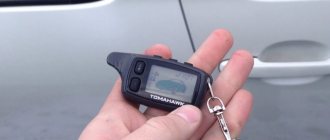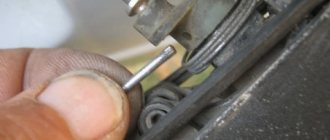On a frosty morning, you plan to go to work or on business in a car that you parked outside your house the night before, but you can’t get into the interior - the lock is frozen and needs to be warmed up. What to do and how to quickly solve the problem?
Why do castles freeze?
First you need to define the concept. The fact is that the lock cylinder or its mechanism may freeze. That is, you cannot insert the key, the keyhole is frozen. Or the central locking mechanism cannot unlock the door from the alarm.
Another option is that the door seals to the body are simply frozen. This time the locking mechanism opens, but the doors remain closed. Because they are held by ice between the door seals.
In these cases, defrosting needs to be done differently. Therefore, we will consider different options, each with its own way of warming up the car.
They freeze only when exposed to moisture. It doesn’t matter, it’s condensation that formed from the temperature difference between the warm air in the cabin and the frost outside. Or after washing, when water flows where it is not needed. And it’s winter outside, so it freezes along with the locks and rubber bands.
Many people use automotive silicones for rubber bands on car doors and locks. But they don't know how to use them correctly . Therefore, even after treating with lubricant, everything has to be defrosted.
Modern technologies
Nowadays, with the use of modern technologies, winter frosts can be more easily met.
Effective means for defrosting car keyholes are:
- Hydrophobic liquids - Lukoil, Luqui Moly, Wesco;
- Powerful electric hair dryer that runs on batteries;
- Silicone Grease;
- Compact keychain with the ability to defrost. It works autonomously and has an ergonomic appearance. The design consists of a device made in the form of a probe. Heats up to a temperature of 120 degrees in a matter of seconds from an internal electric current source.
Necessarily! The defrosting process is completed by treating the mechanism with a specialized compound, such as WD-40.
How to open a door in the cold - a general example
Let's consider the general case when the door is frozen. It doesn’t matter here whether the lock or the door seal is frozen. Or maybe the handle is frozen and does not open the mechanism. What to do in this case?
First of all, we check all the doors . Maybe one of them is opening. If so, then we’ll climb through it into the car’s interior. We start the engine and turn on the heater. The interior of the car will warm up along with the engine. After some time, the doors and locks will thaw and can be opened.
It happens that out of four doors, not one opened, but only the trunk gave in. You can climb through it. In this case, it will be more convenient for owners of station wagons and hatchbacks to do this. I can’t do this trick in my VAZ 2107; there is a blank metal partition between the trunk and the interior.
How to defrost locks? They use alcohol-containing solutions, use local heating, and some use brute force. We will analyze each of these methods in detail.
What to do if a car door is frozen?
You left your car in the cold for literally two or three hours and when you try to open it you realize that the door is frozen almost tightly. What to do? How to fix it? If a car door is frozen, you can do this: using a brush (or, if you don’t have one, any other tool available to you), carefully clear the snow from the edges of the car doors. If you don’t have a brush at hand, and your tool is a knife, a regular screwdriver or some kind of key, then you should act very carefully and carefully. Very carefully pull the car door towards you. She didn't give in at all? Then apply a little pressure and gently tap the edges. Then pull the door towards you again. Repeat this simple procedure several more times until you manage to open the doors.
If one of the doors is very frozen, you can try opening the trunk of the car or the second door. In addition, you can use all kinds of alcohol-containing liquids. It is necessary to lubricate the seals and door edges with such products. An excellent effect is achieved using a regular hair dryer. But, of course, if the door is frozen in the parking lot, then this method will not be available for use.
Never pour boiling water on car doors, as it can easily damage the paintwork. Do not use extreme force when opening the door, as this may damage the handles or the door itself. It would also not be a good idea to tear off a frozen seal from a car door using coins, keys or knives.
Method No. 1 - Brute physical force, the key does not turn
If you are lucky and were able to insert the key into the lock, then there is a good chance of opening the frozen door. With small movements we turn it in the keyhole to the left and to the right. At the same time we tap around it.
Thus, we are trying to loosen the mechanism and knock the ice off it. The fact is that ice can form not only in the lock, but also inside the door.
If you feel that the key has begun to turn at a larger angle, then we continue to loosen it. When there are no changes in amplitude, then we move on to the second method.
Important. You cannot apply much force to the key. If it does not turn in the lock, then you cannot put too much pressure on it. You can break it. And the worst thing will be that part of it will remain in the lock, and it will be even more difficult to open the frozen door.
Preliminary processing
To reduce the problem with the lock freezing, it is necessary to treat the parts with the necessary means. The choice is great:
- Use multi-purpose lubricant. This is mineral oil without special additives;
- You can apply motor oil if necessary;
- It is best to pre-treat all locking mechanisms and door hinges with a specialized lubricant with adhesive properties. Since these parts have friction with each other, the engine oil will not hold onto them. Important: locks should not be treated with this product in any way.
Method No. 2 – Defrost with a heated key or open fire
- Heat the key to defrost the lock. This could be a long time.
- Or warm the keyhole. There is a chance of damaging the door paint.
In the first case, we heat the key . To do this, you can use a lighter. Having warmed it up, we try to insert it into the lock. The lock should thaw based on the temperature of the key. If it doesn't work the first time, try again. Depending on the outside temperature, you may have to do this several times.
It is important that the key should not be overheated. Remember, you can damage the plastic handle of the key and the electronics inside it. In addition, if you heat it with a lighter for a long time, it will also become very hot. It will be difficult to hold it in your hands. Therefore, you need to use gloves or a rag.
If you feel sorry for a car key, then you can use other thin objects that can get into the keyhole. For example, a pin or hairpin. Here, too, you need to observe safety measures. Handle metal objects with gloves or rags.
How to do it correctly:
- We put gloves on our hands, mittens - anything that will protect our hands from burns.
- Heat a key or other narrow and thin object with a lighter.
- Carefully bring it to the keyhole. Let's try to insert it inside.
If you don’t want to ruin the key, then look for a long and narrow object. We insert one end of it into the lock. We hold the other end in mittens. With the other hand, use a lighter to heat this object along its entire length. Gradually insert it until it stops. This will completely thaw the keyhole. You can now use the key.
The second case is the use of open fire. We warm the keyhole with it.
For this you will need:
- Lighter. It is better to use “non-damping”. They have a directional flame that can be directed directly towards a frozen castle.
- Smoldering cigarette. We bring it close to the larva. Remember, smoking is harmful to your health.
This method of defrosting a car lock can damage the car's paintwork. Therefore, act extremely carefully, do not heat the larva for a long time, so as not to damage the varnish due to its temperature.
Experiment 3. WD-40, also called “Vedashka”
You start the process by spraying the can through a thin tube, the liquid gets inside, destroys the ice and removes excess moisture, wait a few seconds and try to turn the key.
However, it should be remembered that there is no need to get too carried away with the “Vedashka”, because subsequently the remaining substance will absorb dirt and dust.
If this method does not work, we try the same old-fashioned method.
Method number 3 – Heat with water or salt
An old method of warming up car locks and door handles.
- At home we heat water and pour it into a plastic bottle.
- You can use salt or sand instead of water. Pre-heat it in a frying pan and pour it into a rag or mitten. We tie it up and carry it to the car.
To defrost car door handles, you need to pour hot water on them. At the same time, we pull it towards us and let it go - we walk around it.
You can't fill a keyhole like that. Although, you can try. There is a chance of ruining the paint. It is better to lean a warm bottle against the door lock. You will have to wait a while for the heat from it to defrost the mechanism.
We proceed in a similar way with a mitten of sand or salt. There is no need to empty its contents. We simply apply it to a frozen lock or door handle. We wait and periodically try to walk them around.
Method number 5 – Chemistry
There are quite a few liquids in stores for defrosting car locks. They are called "defrosters". They are sold in bottles or cans. They have a narrow spout or tube.
We insert the spout into the keyhole and pour liquid into the lock. We do the same with the spray can, send its tube there and spray it several times. The chemical composition must react with the ice and melt it.
In order not to buy special equipment, you can replace lock defrosters with alcohol . Some people take antifreeze and use a syringe to pour it into the keyhole so that it thaws. But this is inconvenient to do, since you cannot carry the syringe in your jacket, and it is inconvenient to store it in the car. If the car freezes, you won’t get inside, which means you won’t be able to get the syringe.
Experiment 4. Boiling water
The most ancient method, which is used simply when absolutely necessary, is to warm the door. It is usually worth trying to remove the rubber gasket between the door and the glass and pour boiling water into the resulting gap.
If you're wrong, the story will only get worse. Because the moisture will freeze inside the door even more, and then you will definitely not get into the car.
How to open frozen car doors
Let's say you managed to cope with the fitted locks. But the door doesn't open. What to do? You won't be able to melt them in the cold, but there are ways to open them without improvised means.
- Knock around the entire perimeter of the door to knock the ice off the seals. We knock without fanaticism, so as not to break the glass or bend the metal.
- Open the trunk if it is not frozen. Slam the lid firmly on it. Due to the vibration in the body from the impact, the ice should fall off the door rubbers.
How to remove moisture or protect a car lock from freezing
Silicone grease is used to remove moisture from car locks. It repels water, protecting metal and rubber surfaces from freezing.
Apply silicone to the key. We insert it into the cylinder and turn it several times in one direction and the other. This way the lubricant is distributed evenly throughout the entire mechanism.
If there is no automotive silicone oil, then you can use hygienic lipstick . No matter how funny it may sound, it also contains silicone. Rub the key with it and repeat the procedure several times. This will ensure that your lock will not freeze for several weeks.
After 2-3 weeks, depending on the weather, it is advisable to repeat the procedure.
Rubber door seals can be protected in the same way. I described in detail how to apply silicone correctly in previous articles. Look for them on the website.
Prevention
The best way to deal with frozen locks is timely preventive measures:
- Always dry the lock after washing your car. If the process takes place at a car wash, then make sure that the establishment’s employees do this.
- A good old-fashioned method is to add graphite powder to the dried castle.
- Try to protect the castle from precipitation (for example, in the yard it is better to park the car under some kind of canopy).
- To lubricate locks, use only special compounds.
- Complete your car in the fall. You should have a lock defroster, winter lubricant for hinges, and a product to prevent rubber bands from freezing on hand (silicone lubricant will also work).
- Wipe rubber seals from moisture. For greater efficiency, it is advisable to do this work in cold weather. Then treat the rubber seals with the “silicone” mentioned above.
- Use a car cover. If you live in a region with harsh weather conditions, then using a quality cover may come in handy. Of course, the product will not protect 100%, but it can reduce the risk of the lock freezing.
- Park your car in an area that receives more sunlight and less wind.











